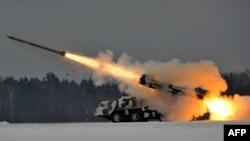Devastating multiple-launch rocket systems, heavy flamethrowers and advanced anti-tank missiles are among new weapons Armenia will buy from Russia soon with a $200 million Russian loan, it emerged on Thursday.
The Russian government posted on one of its websites a copy of the loan agreement that was signed by the two sides in Yerevan in June last year. The Armenian and Russian parliaments ratified it later in 2015.
Armenian officials have until now declined to specify the Russian weapons to be purchased with the relatively low-interest loan repayable in 13 years. They have said only that the Armenian army does not have most of them in its current arsenal.
The publicized agreement carries a long list of defense items which Yerevan will be able to purchase from Russian manufacturers by the end of 2017. But it does not specify their quantities.
The heaviest weapon on that list is the Smerch multi-launch rocket system with a firing range of up to 90 kilometers. One of the most destructive weapons of its kind in the world, it can fire 12 300-milimeter rockets in less than a minute.
The Armenia military reportedly acquired in 2011 six Chinese-made AR1A systems that have many technological similarities with Smerch. Both rocket launchers are designed to attack concentrations of troops, command centers and important ground targets.
The publicized list also includes TOS-1A heavy flamethrower systems that can fire up to 24 incendiary or thermobaric rockets in a single salvo. With a 6-kilometer range, the rockets are meant to destroy defense fortifications, enemy personnel, armored vehicles and transport.
Russia reportedly sold 18 Smerch launchers and as many TOS-1A flamethrowers to Azerbaijan in accordance with defense contracts signed in 2009-2010.
The Russian-Azerbaijani arms deals worth more than $4 billion have raised serious concerns in Armenia. Some Armenian politicians and commentators have accused Moscow of undercutting its main regional ally. The Russian arms loan might have been aimed at placating the Armenians.
The agreement on its disbursement coincided with dramatic street protests in Yerevan against a rise in electricity price engineered by Armenia’s Russian-owner national electric utility. The so-called “Electric Yerevan” movement raised Russian fears of yet another Western-backed another “color revolution” in the former Soviet Union. The funding for fresh Russian arms supplies to Yerevan was therefore construed by some observers as an attempt to bolster the Armenian government.
An annex to the 2015 Russian-Armenian agreement revealed on Thursday says that the Armenian government will also spend the $200 million loan on buying Russian-made anti-tank weapons, shoulder-fired surface-to-air missiles, demining and communication equipment, armored personnel carriers and heavy military trucks.
The anti-tank systems include 9M133 guided missiles that first went into service with the Russian army in the late 1990s.The 135-milimeter rockets can supposedly destroy tanks within a 4-kilometer range.
Citing another Russian-Armenian accord signed in 2013, Armenian military official stress that Yerevan can now buy brand new weapons at domestic Russian prices that are well below international market-based levels. The 2015 loan agreement makes a reference to that deal.
The military alliance with Russia has already enabled Armenia to receive many Russian weapons at discount prices or even free of charged over the past two decades. That has put it in a position to fully or partly offset Azerbaijan’s massive military buildup fueled by oil revenues. Ohanian thanked Moscow for its “huge” military assistance when he met with Russian Defense Minister Sergey Shoygu in Moscow in December.
A Russian-Armenian intergovernmental commission on bilateral “military-technical cooperation” most probably discussed the fresh arms deliveries to be financed by the Russian loan when it met in Yerevan late last month. Few details of the four-day meeting were made public.





